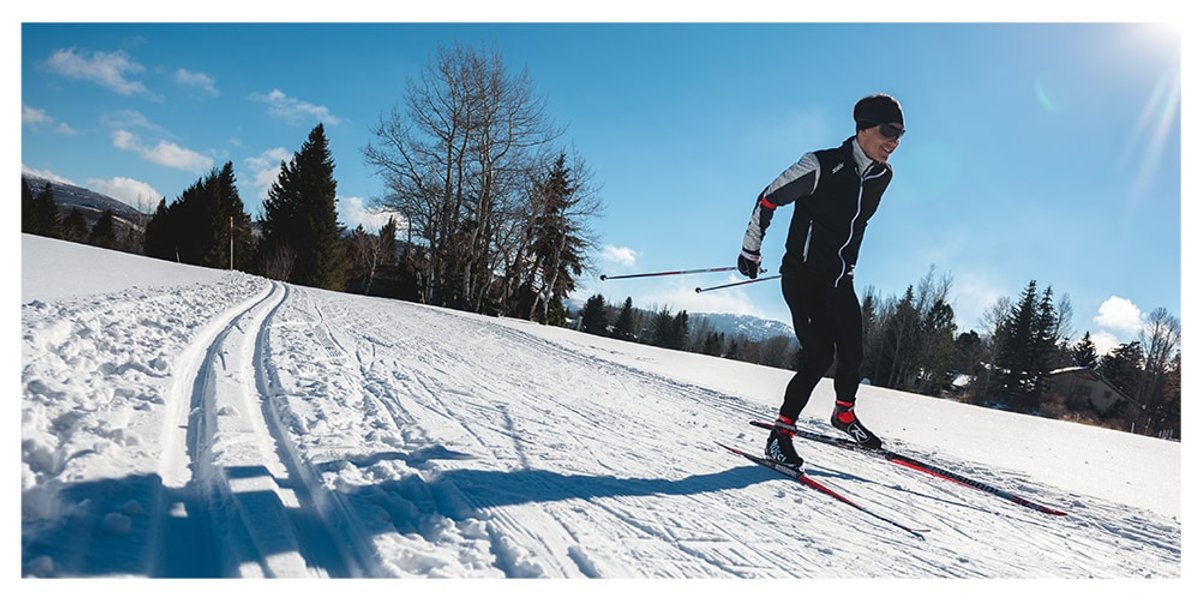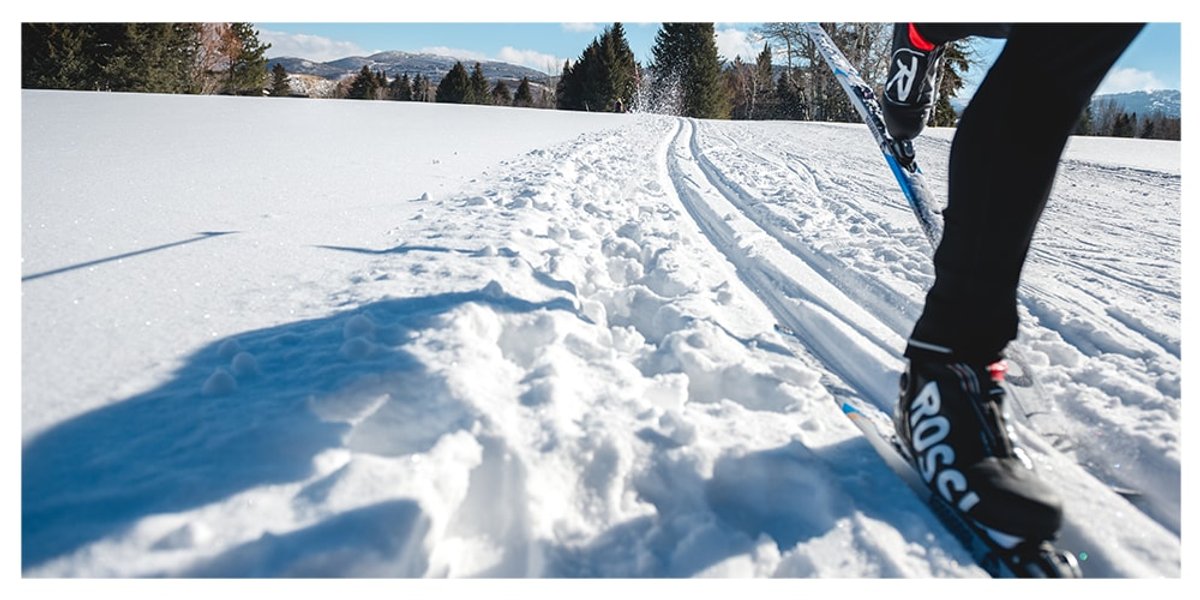
Whether you’re an avid downhill skier hitting the trails after work or a nature lover escaping into the forest, cross-country skiing is an exciting way to explore winter’s snowy wonderland. But there are two ways to go Nordic: classic cross country skiing and skate skiing. Whichever Nordic branch you choose, cross country skiing is an excellent workout and a great way to get outside in the winter, especially when the downhill skiing and snowboarding conditions are less than enticing.
To the untrained eye, skate skiing and classic cross country skiing look similar—they both employ skinny skis, poles, boots, and bindings. However, the difference between skate ski and classic is akin to the difference between road and mountain biking. Skate and classic skiers require different types of terrain, use contrasting techniques, and are equipped with specialized cross country ski gear.
Skate Skiing
Skate skiing takes place primarily on groomed tracks. Like its name suggests, the movement of skate skiing is comparable to that of ice (or inline) skating. This is the style of Nordic skiing that you see in Olympic biathlons, wherein spandex-clad super athletes skate their way up big hills and tuck into descents, taking the occasional breather to fire a rifle at a target.
The primary skate ski technique is the aptly named V style. At its simplest, the V style involves loosely forming a V shape with your skis, in which the back tips are pointed inwards, while the front tips are pointed outwards. Alternating legs, the skier drives off the outer edge of the ski, creating speed, while transferring weight off the other ski to glide forward.
The V style is most easily mastered on flat or gentle uphills. When the pitch climbs steeper, it can be hard to find your flow on skate skis, and many skiers resort to a mix of gliding and edging their way up. To go downhill, you maneuver your skis to be parallel, do a squat (think chair pose, if you’re into yoga), and tuck poles into chest to aerodynamically coast.
At its best, skate skiing is the picture-perfect blend of speed and fluidity—of course, that’s dependent on how coordinated and competent you are on skate skis! And whether you’re on flat terrain or charging uphill, it’s an incredible cardiovascular workout that will also leave your triceps sore the next day.
Tune up your skate ski technique with five-time Olympian and World Cup champion Billy Demong.

Skate Skis: Since skate ski technique positions the skis in a V shape, cross country skate skis are shorter than classic skis. Shorter skate ski sizing makes them easier to control in the V position, minimizing the chance of crossed tips while kicking and gliding. Since speed is the name of the game in skate skiing, most skate skis are lighter, narrower, stiffer, and have longer, less pronounced camber than classic. Because skate skiers use the edge of the ski for propulsion, skate skis do not have a “kick zone” or “wax pocket” like classic skis.
Skate Ski Boots: Much like cross country skate skis, skate ski boots are stiffer and lighter than classic boots. Skate ski boots have firm soles to minimize forward flex, and higher, firmer ankle support to guard against the repetitive twisting motion of skate skiing.
Skate Ski Poles: Poles are vital to skate ski technique, allowing you to push off the snow with your upper body, core, and legs, resulting in faster speeds. The ideal length of a skate ski pole begins on the ground and ends somewhere between your chin and lips. A stiff, sturdy pole is desirable for transferring both power and longevity.

Classic Cross Country Skiing
When most people think of cross country skiing, classic style comes to mind. It’s generally thought that classic skiing is the easier style to learn. The movement is similar to walking or shuffling—the skis remain parallel and are driven forward by pressing the “grip zone” (also called “kick zone” or “wax pocket”) into the snow, gliding forward, then repeating the motion with the other leg.
Classic skiing is also more versatile—you can do it on narrow, parallel groomed tracks or deep in the woods—so it’s a popular choice for people who want one pair of skis to do it all.

Classic Skis: Classic skis are long and narrow—the maximum width of a pair of classic Nordic touring skis is 70mm. It’s no coincidence that 70mm is also the standard width of a groomed track.
Classic skis are shaped like a bow (camber), and when weighted evenly, the front and back third of the ski sit on the snow while the middle—grip zone—floats above the snow. When one ski is fully weighted, the grip zone is engaged. The grip zone freely glides forward but resists sliding backward, creating friction that propels you ahead. Classic skis are commonly categorized based on the type of grip zone they possess: waxless or waxable.
- Waxless: Waxless classic Nordic touring skis use fish scales (a textured pattern) in the kick zone, rather than a kick wax, hence, the waxless moniker. Although waxless skis don’t require a kick wax, the tips and tails do require occasional waxing.
- Waxable: Waxable classic skis use a kick wax in their wax pocket for traction. Skiers must match their wax to the conditions, which equates to more maintenance—but when matched properly, a waxable ski will outperform a waxless ski. However, precisely matching wax to weather takes experience, making them the choice of more seasoned skiers.
Classic Cross Country Ski Sizing: In the old days, classic cross country ski sizing was easy: stand with one arm raised and measure from your wrist to the ground. Today, sizing is based on two primary factors: weight and ability.
- Weight: Weight is the most important factor, because you need to be heavy enough to flex the ski in order to engage the kick zone.
- Ability: More advanced skiers favor longer, stiffer skis for their improved glide and speed, while cross country skis for beginners are shorter and softer for easier maneuverability.
Classic Ski Boots: Classic boots tend to be shorter and made with more flexible materials than skate skiing boots. Size classic ski boots so that they’re snug but not constricting. Your heel should feel locked in place (if not, expect blisters) but you should have enough room to wiggle your toes.
Classic Ski Poles: In general, classic ski poles should begin at the ground and end at your armpit. If you’re spending a lot of time at the track or speed is of the essence, size them a little longer. The top of your shoulder is a good reference point.
A Wonderful Winter Activity
In the battle of classic vs. skate skiing, both styles are winners. In fact, many cross country skiers do both, giving them maximum flexibility in terms of both terrain and style. The skills learned in each discipline transfer, making the dual practitioner a better cross country skier overall. If you’re ready to get started cross country skiing this winter, read about how to choose the best cross-country skis for you, as well as our Cross Country Ski Guide.
A former child model, Tim Peck spent a portion of his youth gracing the pages of Sunday paper advertisements for many now-defunct department stores. Living responsibly/rent-free with his parents into his thirties, Tim pursued climbing, skiing, and biking while logging an impressive amount of time in the mountains (and accumulating gear accordingly). Relentlessly pursuing the dream, Tim’s modest life ambitions are to ski all 12 months of the year, to climb 5.12, and to live in a van. Follow him on Instagram here.